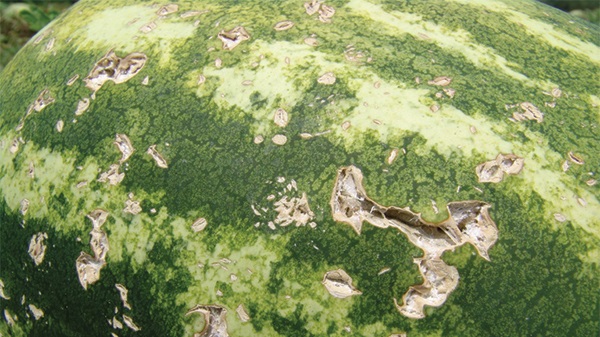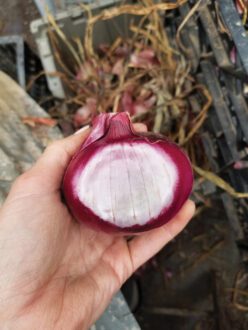

Oct 25, 2023Biotic vs. abiotic: Diagnosing plant damage
When growers think of plant diseases, they usually consider those that are caused by living organisms like fungi, bacteria, viruses and nematodes. These diseases are termed “biotic” and are infectious, meaning that under the right environmental conditions, they can spread from plant to plant.
Many plant disorders can also be a result of “abiotic,” or non-living issues, such as cold injury, nutritional deficiencies, drought, mechanical injuries and herbicide drift or other chemical damage. It can be challenging to tell the difference between the two kinds of diseases just by looking at the symptoms. Plant disease symptoms, whether abiotic or biotic, are typically not specific.
For example, dieback or wilt in the top of the tomato plant could be a result of a root rot caused by fungi (biotic), a stem canker caused by a bacterial disease (biotic), or it could be drought stress (abiotic) — we just need to dig a little deeper to figure out the cause.
Signs of biotic disease
The first thing I do when trying to diagnose a problem is to look for signs or physical evidence of the presence of infectious pathogens. Signs of fungi include spores that can be seen with the naked eye (e.g., powdery and downy mildews), fruiting bodies (usually with the aid of a 15X hand lens), threads of the fungus called mycelia or long-term overwintering structures called sclerotia, as is common in white mold (Sclerotinia spp.).


Bacterial signs are not as obvious, although you may see ooze or strands of bacteria as in the case of a cut cucurbit stem with bacterial wilt. Sometimes you can only see the signs under a microscope by looking for bacteria streaming out of the cells.
Viruses leave no signs; we can only guess by symptoms, which include distorted tissue, mottling, ring spotting and stunting, among others. For positive identification, further testing must be done in laboratories that have the proper equipment.
Nematodes are identified by microscopic examination and, in some cases, by the presence of cysts or galls as in root knot nematodes or the soybean cyst nematode.
Signs of abiotic disease
If there are no signs of pathogens present on the plant, the next step is to consider whether the symptoms are caused by abiotic or non-living issues. There are several clues that help identify a problem as abiotic.
Timing
Abiotic problems often occur quickly, unlike infectious pathogens that develop and spread slowly. For example, a frequent problem in late winter or early spring is ethylene damage in greenhouse tomatoes.


This damage, often a result of cracks or leaks in heaters, causes curling, twisting and distortion in plants, and tomatoes are extremely sensitive. One day the plants look perfectly fine, then the next day the entire crop is showing symptoms.
Edema is another abiotic problem that can occur quickly. Edema follows bouts of cool, cloudy weather. The plants take up water but don’t transpire it because it is cloudy. The fluid builds up in the cells and then bursts causing corky ridges often along the veins.
Weather damage, like hail and lightning, are other examples of abiotic problems that occur quickly after one-time events.
Pattern of damage
If an entire crop is affected, this is another clue that the problem is related to a non-living cause. An infectious disease would cause symptoms hit or miss throughout the high tunnel or field, not typically large numbers of plants all at once. An example is magnesium deficiency in high tunnel tomatoes. You see it consistently throughout the entire crop typically on the older or lower leaves of the plant.
Additionally, patterns of injury may crop up when some rows of vegetables are over- or under-fertilized or when the dripline in one row is clogged compared with another row that received the proper amount of fertilizer or water. Injuries limited to one side of the plant or fruit may also indicate an abiotic cause.
Multiple plant species affected
If more than one species of plant is affected, this is likely the result of an abiotic cause. Infectious pathogens are typically very host-specific so something that attacks a tomato would not likely attack a lettuce crop. I often get calls from growers thinking the powdery mildew on their cucurbits is spreading to the high tunnel tomatoes. Powdery mildews look the same, but each powdery mildew is very host-specific to the crop.
While it may seem that the disease is spreading from one species of crop to another, it is because all powdery mildews like the same humid conditions, so they tend to develop at the same time.
Age of tissue affected
Abiotic symptoms are often limited to one age of tissue. I often ask growers with crop problems to note if the damage is only on the lower, older leaves or on the new leaves.
They often report the older leaves look terrible, but the new growth looks healthy. In these cases, the damage could have happened when the plant was small when the foliage was vulnerable and damaged from a one-time event. This is quite common in young vegetable transplants that were exposed to low temperatures or not hardened off adequately. This can also happen to fruit, as in the case of blossom end rot, (poor calcium movement) or catfacing caused by cold temperatures in tomatoes. The earlier fruit is affected but the later fruit is free of damage.
Gradient of injury
This often occurs if there is heater injury and herbicide damage. The plants nearest the heater or closer to the sprayer look the worst and as you move farther away, the plants look better.
Getting help to diagnose diseases
The good news about abiotic damage is that it often results from a one-time event, so if the roots are healthy (which you have already checked), the new growth should look better in a few days. Diagnosing plant problems can be tricky, so remember that all land grant universities have plant diagnostic clinics ready to assist with problem-solving.
— Ann Hazelrigg, Extension associate professor, University of Vermont
Top photo: Hail damage on a watermelon, a day after a storm. Photo by Gerald Holmes, Cal Poly Strawberry Center, courtesy of Bugwood.org.














